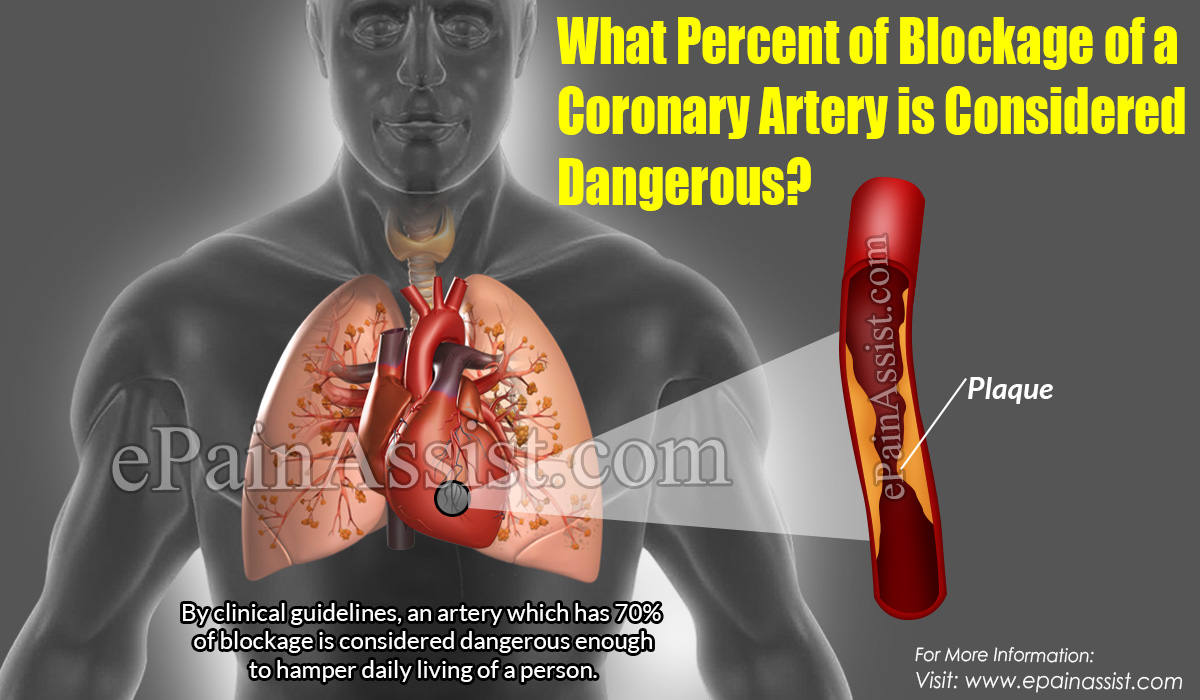Plaque can start accumulating in an artery from a very young age. As the person grows older the plaque builds up leading to inflammation of the artery wall while increasing the risk of heart attack and blood clots. The plaque makes the inner wall of the artery sticky with the deposition of fat, calcium and cholesterol. This makes the artery narrower thereby failing to deliver blood to the heart muscles. At times, the plaque so formed may rupture and a blood clot formed may completely shut down blood supply to the heart muscle. This causes heart attack.

What Percent of Blockage of a Coronary Artery is Considered Dangerous?
Blockage of a coronary artery is a condition where an artery which carries oxygen-rich blood to the heart muscle gets blocked or narrowed due to plaque deposits. This is medical condition is known as Coronary Artery Disease (CAD). By clinical guidelines, an artery which has 70% of blockage is considered dangerous enough to hamper daily living of a person. With such percentage of blockage, a patient might have to undergo angioplasty and/or stenting.
- The most common symptom of CAD or Coronary Artery Disease is chest pain also called Angina. Angina can be described as feelings of heaviness, aching and pressure in heart and feeling of numbness.
- Patient may experience shortness of breath
- Incidents of nausea, sweating, dizziness can also be experienced.
- Patient may experience an irregular heartbeat or skipped beat commonly known as palpitation.
What are the Complications Related to Coronary Artery Blockage?
Coronary artery blockage increases the risk of heart attack in patients. Patients also become susceptible to heart failure. This happens because of chronic deprivation of oxygenated blood to the heart muscle. Inadequate blood supply to the heart can damage heart tissue which interferes with heart’s electrical impulses causing irregular heartbeats.
What do to When the Blockage Reaches the Threshold?
As mentioned earlier, the threshold for a coronary artery blockage to be considered dangerous is 70%. The doctors in such cases recommend patients to go for an angiogram. This gives the doctor an idea of the magnitude of blockage so formed. If the blockage happens to be 70% or more, angioplasty and stenting are to be done to reduce the blockage whether or not the patient is symptomatic. Angioplasty is a minimally invasive procedure to clear heart blockages. It must be remembered that angioplasty is applicable for a limit of blockages in two arteries at most. If more than two blockages are detected, a bypass surgery is recommended.
What To Do So That The Blockage Does Not Exceed?
A healthy and active lifestyle is the key to healthy blood vessels and proper blood supply to the heart.
- Since cholesterol contributes to plaque formation, maintaining a low level of cholesterol can help prevent deterioration of CAD.
- Patient should make efforts to reduce obesity and maintain a healthy body weight. This is because obesity leads to greater amount of fatty deposits.
- Intake of alcohol should be limited by patients with CAD.
- Balanced diet should be maintained by patients having heart blockage. Intake of healthy food, with the minimum amount of oil consumption, is recommended.
- Patients are recommended to undertake a regular physical exercise to keep the heart healthy. Immobility can at times lead to increase in the magnitude of heart blockage.
- Diabetes and high blood pressure should be controlled as much as possible.
- Smoking is strictly not recommended for patients with coronary artery blockage.
- In case of minor blockage of an artery, the physician can prescribe medication as a part of the wellness plan.
- Above all, it is advised to know about the risk factors associated coronary artery blockage.
